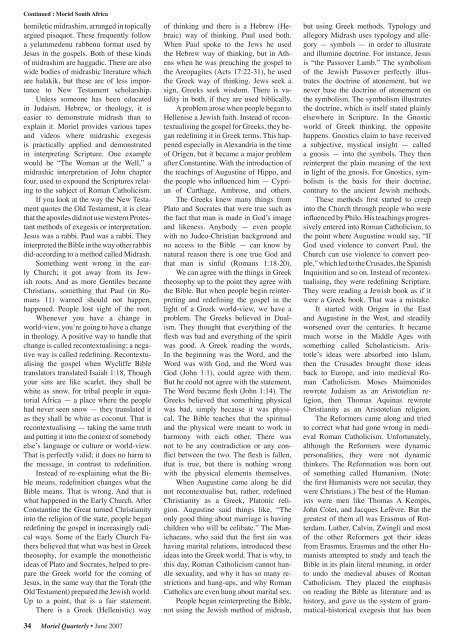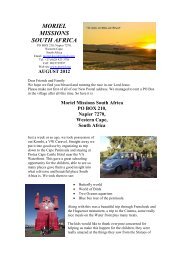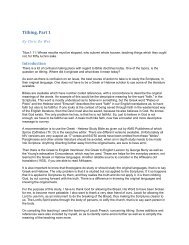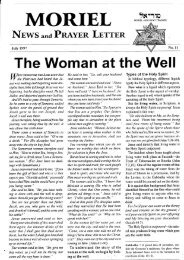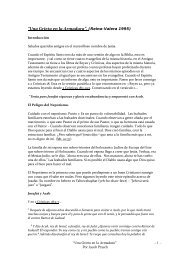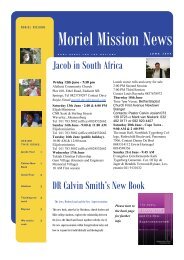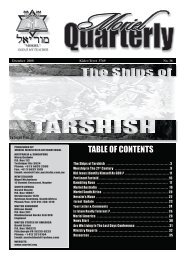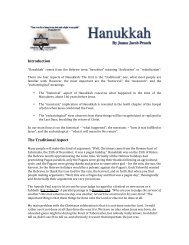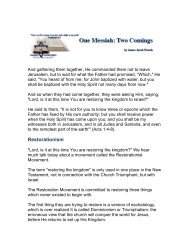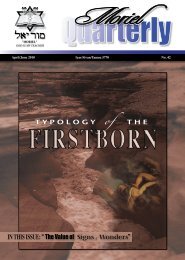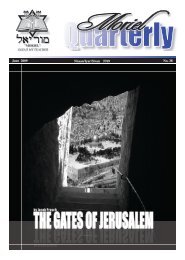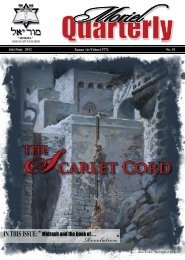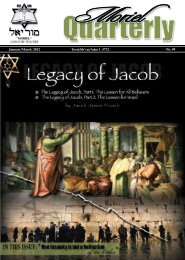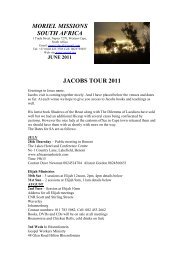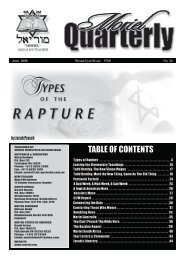Spiritual Warfare and Territorial Spirits (~5.5 MB) - Moriel Ministries
Spiritual Warfare and Territorial Spirits (~5.5 MB) - Moriel Ministries
Spiritual Warfare and Territorial Spirits (~5.5 MB) - Moriel Ministries
Create successful ePaper yourself
Turn your PDF publications into a flip-book with our unique Google optimized e-Paper software.
Continued : <strong>Moriel</strong> South Africahomiletic midrashim, arranged in topicallyargued pisaqaot. These frequently followa yelammedenu rabbenu format used byJesus in the gospels. Both of these kindsof midrashim are haggadic. There are alsowide bodies of midrashic literature whichare halakik, but these are of less importanceto New Testament scholarship.Unless someone has been educatedin Judaism, Hebrew, or theology, it iseasier to demonstrate midrash than toexplain it. <strong>Moriel</strong> provides various tapes<strong>and</strong> videos where midrashic exegesisis practically applied <strong>and</strong> demonstratedin interpreting Scripture. One examplewould be “The Woman at the Well,” amidrashic interpretation of John chapterfour, used to expound the Scriptures relatingto the subject of Roman Catholicism.If you look at the way the New Testamentquotes the Old Testament, it is clearthat the apostles did not use western Protestantmethods of exegesis or interpretation.Jesus was a rabbi. Paul was a rabbi. Theyinterpreted the Bible in the way other rabbisdid-according to a method called Midrash.Something went wrong in the earlyChurch; it got away from its Jewishroots. And as more Gentiles becameChristians, something that Paul (in Romans11) warned should not happen,happened. People lost sight of the root.Whenever you have a change inworld-view, you’re going to have a changein theology. A positive way to h<strong>and</strong>le thatchange is called recontextualising; a negativeway is called redefining. Recontextualisingthe gospel when Wycliffe Bibletranslators translated Isaiah 1:18, Thoughyour sins are like scarlet, they shall bewhite as snow, for tribal people in equatorialAfrica — a place where the peoplehad never seen snow — they translated itas they shall be white as coconut. That isrecontextualising — taking the same truth<strong>and</strong> putting it into the context of somebodyelse’s language or culture or world-view.That is perfectly valid; it does no harm tothe message, in contrast to redefinition.Instead of re-explaining what the Biblemeans, redefinition changes what theBible means. That is wrong. And that iswhat happened in the Early Church. AfterConstantine the Great turned Christianityinto the religion of the state, people beganredefining the gospel in increasingly radicalways. Some of the Early Church Fathersbelieved that what was best in Greektheosophy, for example the monotheisticideas of Plato <strong>and</strong> Socrates, helped to preparethe Greek world for the coming ofJesus, in the same way that the Torah (theOld Testament) prepared the Jewish world.Up to a point, that is a fair statement.There is a Greek (Hellenistic) way34 <strong>Moriel</strong> Quarterly • June 2007of thinking <strong>and</strong> there is a Hebrew (Hebraic)way of thinking. Paul used both.When Paul spoke to the Jews he usedthe Hebrew way of thinking, but in Athenswhen he was preaching the gospel tothe Areopagites (Acts 17:22-31), he usedthe Greek way of thinking. Jews seek asign, Greeks seek wisdom. There is validityin both, if they are used biblically.A problem arose when people began toHellenise a Jewish faith. Instead of recontextualisingthe gospel for Greeks, they beganredefining it in Greek terms. This happenedespecially in Alex<strong>and</strong>ria in the timeof Origen, but it became a major problemafter Constantine. With the introduction ofthe teachings of Augustine of Hippo, <strong>and</strong>the people who influenced him — Cyprianof Carthage, Ambrose, <strong>and</strong> others.The Greeks knew many things fromPlato <strong>and</strong> Socrates that were true such asthe fact that man is made in God’s image<strong>and</strong> likeness. Anybody — even peoplewith no Judeo-Christian background <strong>and</strong>no access to the Bible — can know bynatural reason there is one true God <strong>and</strong>that man is sinful (Romans 1:18-20).We can agree with the things in Greektheosophy up to the point they agree withthe Bible. But when people begin reinterpreting<strong>and</strong> redefining the gospel in thelight of a Greek world-view, we have aproblem. The Greeks believed in Dualism.They thought that everything of theflesh was bad <strong>and</strong> everything of the spiritwas good. A Greek reading the words,In the beginning was the Word, <strong>and</strong> theWord was with God, <strong>and</strong> the Word wasGod (John 1:1), could agree with them.But he could not agree with the statement,The Word became flesh (John 1:14). TheGreeks believed that something physicalwas bad, simply because it was physical.The Bible teaches that the spiritual<strong>and</strong> the physical were meant to work inharmony with each other. There wasnot to be any contradiction or any conflictbetween the two. The flesh is fallen,that is true, but there is nothing wrongwith the physical elements themselves.When Augustine came along he didnot recontextualise but, rather, redefinedChristianity as a Greek, Platonic religion.Augustine said things like, “Theonly good thing about marriage is havingchildren who will be celibate.” The Manichaeans,who said that the first sin washaving marital relations, introduced theseideas into the Greek world. That is why, tothis day, Roman Catholicism cannot h<strong>and</strong>lesexuality, <strong>and</strong> why it has so many restrictions<strong>and</strong> hang-ups, <strong>and</strong> why RomanCatholics are even hung about marital sex.People began reinterpreting the Bible,not using the Jewish method of midrash,but using Greek methods. Typology <strong>and</strong>allegory Midrash uses typology <strong>and</strong> allegory— symbols — in order to illustrate<strong>and</strong> illumine doctrine. For instance, Jesusis “the Passover Lamb.” The symbolismof the Jewish Passover perfectly illustratesthe doctrine of atonement, but wenever base the doctrine of atonement onthe symbolism. The symbolism illustratesthe doctrine, which is itself stated plainlyelsewhere in Scripture. In the Gnosticworld of Greek thinking, the oppositehappens. Gnostics claim to have receiveda subjective, mystical insight — calleda gnosis — into the symbols. They thenreinterpret the plain meaning of the textin light of the gnosis. For Gnostics, symbolismis the basis for their doctrine,contrary to the ancient Jewish methods.These methods first started to creepinto the Church through people who wereinfluenced by Philo. His teachings progressivelyentered into Roman Catholicism, tothe point where Augustine would say, “IfGod used violence to convert Paul, theChurch can use violence to convert people,”which led to the Crusades, the SpanishInquisition <strong>and</strong> so on. Instead of recontextualising,they were redefining Scripture.They were reading a Jewish book as if itwere a Greek book. That was a mistake.It started with Origen in the East<strong>and</strong> Augustine in the West, <strong>and</strong> steadilyworsened over the centuries. It becamemuch worse in the Middle Ages withsomething called Scholasticism. Aristotle’sideas were absorbed into Islam,then the Crusades brought those ideasback to Europe, <strong>and</strong> into medieval RomanCatholicism. Moses Maimonidesrewrote Judaism as an Aristotelian religion,then Thomas Aquinas rewroteChristianity as an Aristotelian religion.The Reformers came along <strong>and</strong> triedto correct what had gone wrong in medievalRoman Catholicism. Unfortunately,although the Reformers were dynamicpersonalities, they were not dynamicthinkers. The Reformation was born outof something called Humanism. (Note:the first Humanists were not secular, theywere Christians.) The best of the Humanistswere men like Thomas A Kempis,John Colet, <strong>and</strong> Jacques Lefèvre. But thegreatest of them all was Erasmus of Rotterdam.Luther, Calvin, Zwingli <strong>and</strong> mostof the other Reformers got their ideasfrom Erasmus. Erasmus <strong>and</strong> the other Humanistsattempted to study <strong>and</strong> teach theBible in its plain literal meaning, in orderto undo the medieval abuses of RomanCatholicism. They placed the emphasison reading the Bible as literature <strong>and</strong> ashistory, <strong>and</strong> gave us the system of grammatical-historicalexegesis that has been


